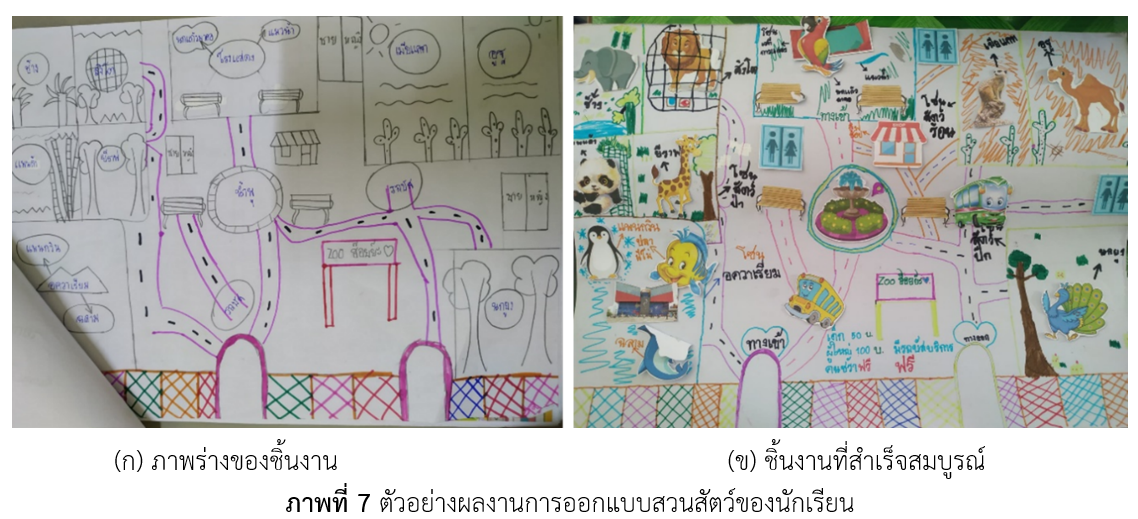การพัฒนากิจกรรมการเรียนรู้วิทยาศาสตร์ตามแนวคิดสะตีมศึกษาเรื่องสวนสัตว์ของคุณหนูเพื่อเสริมสร้างทักษะการคิดสร้างสรรค์ของนักเรียนชั้นประถมศึกษา
Main Article Content
บทคัดย่อ
การศึกษาครั้งนี้เป็นการวิจัยเชิงทดลองขั้นต้น โดยมีจุดมุ่งหมายเพื่อพัฒนากิจกรรมการเรียนรู้วิชาวิทยาศาสตร์ตามแนวคิดสะตีมศึกษา และศึกษาผลการเสริมสร้างทักษะการคิดสร้างสรรค์และความพึงพอใจของนักเรียนหลังจากได้รับการจัดกิจกรรมการเรียนรู้นี้ กลุ่มตัวอย่างของการวิจัยครั้งนี้คือนักเรียนชั้นประถมศึกษาปีที่ 5 ที่ถูกเลือกมาโดยการสุ่ม ประกอบด้วยกลุ่มทดลอง 30 คนและกลุ่มควบคุม 28 คน เครื่องมือของการวิจัยคือแผนการจัดการเรียนรู้วิชาวิทยาศาสตร์ตามแนวคิดสะตีมศึกษาเรื่อง “สวนสัตว์ของคุณหนู” ประกอบด้วยกิจกรรมการเรียนรู้ 6 ขั้นตอนที่พัฒนาขึ้นมาจากการผสานแนวคิดกระบวนการออกแบบเชิงวิศวกรรมร่วมกับแนวคิดการสืบเสาะที่สร้างสรรค์ผ่านอัตลักษณ์วิธีการสอนศิลปะและออกแบบ กิจกรรมนี้ใช้ระยะเวลาในการดำเนินกิจกรรมทั้งสิ้น 6 ชั่วโมง (3 สัปดาห์) แบบประเมินทักษะการคิดสร้างสรรค์และแบบประเมินความพึงพอใจของนักเรียน ผลจากการวิจัยพบว่าผลการประเมินกิจกรรมการเรียนรู้ตามแนวคิดสะตีมศึกษามีความเหมาะสมอยู่ในระดับดีมาก ผลการทดลองใช้กิจกรรมการเรียนรู้นี้พบว่านักเรียนกลุ่มทดลองมีคะแนนเฉลี่ยของทักษะการคิดสร้างสรรค์สูงกว่ากลุ่มควบคุมทุกด้าน สัดส่วนของจำนวนนักเรียนกลุ่มทดลองมีทักษะการคิดสร้างสรรค์อยู่ในระดับดีมากอยู่ร้อยละ 60 ในขณะที่นักเรียนกลุ่มควบคุมส่วนใหญ่ (ร้อยละ 53) อยู่ในระดับพอใช้และไม่พบนักเรียนที่มีทักษะการคิดสร้างสรรค์ในระดับดีมาก และนักเรียนกลุ่มทดลองมีความพึงพอใจต่อกิจกรรมการเรียนรู้ตามแนวคิดสะตีมศึกษานี้อยู่ในระดับมากที่สุด
Article Details

อนุญาตภายใต้เงื่อนไข Creative Commons Attribution-NonCommercial-NoDerivatives 4.0 International License.
วารสารวิทยาศาสตร์และวิทยาศาสตร์ศึกษา (JSSE) เป็นผู้ถือลิสิทธิ์บทความทุกบทความที่เผยแพร่ใน JSSE นี้ ทั้งนี้ ผู้เขียนจะต้องส่งแบบโอนลิขสิทธิ์บทความฉบับที่มีรายมือชื่อของผู้เขียนหลักหรือผู้ที่ได้รับมอบอำนาจแทนผู้เขียนทุกนให้กับ JSSE ก่อนที่บทความจะมีการเผยแพร่ผ่านเว็บไซต์ของวารสาร
แบบโอนลิขสิทธิ์บทความ (Copyright Transfer Form)
ทางวารสาร JSSE ได้กำหนดให้มีการกรอกแบบโอนลิขสิทธิ์บทความให้ครบถ้วนและส่งมายังกองบรรณาธิการในข้อมูลเสริม (supplementary data) พร้อมกับนิพนธ์ต้นฉบับ (manuscript) ที่ส่งมาขอรับการตีพิมพ์ ทั้งนี้ ผู้เขียนหลัก (corresponding authors) หรือผู้รับมอบอำนาจ (ในฐานะตัวแทนของผู้เขียนทุกคน) สามารถดำเนินการโอนลิขสิทธิ์บทความแทนผู้เขียนทั้งหมดได้ ซึ่งสามารถอัพโหลดไฟล์บทความต้นฉบับ (Manuscript) และไฟล์แบบโอนลิขสิทธิ์บทความ (Copyright Transfer Form) ในเมนู “Upload Submission” ดังนี้
1. อัพโหลดไฟล์บทความต้นฉบับ (Manuscript) ในเมนูย่อย Article Component > Article Text
2. อัพโหลดไฟล์แบบโอนลิขสิทธิ์บทความ (Copyright Transfer Form) ในเมนูย่อย Article Component > Other
ดาวน์โหลด ไฟล์แบบโอนลิขสิทธิ์บทความ (Copyright Transfer Form)
เอกสารอ้างอิง
Allina, B. (2018). The development of STEAM educational policy to promote student creativity and social empowerment. Arts Education Policy Review, 119(2), 77-87. https://doi.org/10.1080/10632913.2017.1296392
Belbase, S., Mainali, B. R., Kasemsukpipat, W., Tairab, H., Gochoo, M. and Jarrah, A. (2021). At the dawn of science, technology, engineering, arts, and mathematics (STEAM) education: prospects, priorities, processes, and problems. International Journal of Mathematical Education in Science and Technology, 1-37. https://doi.org/10.1080/0020739X.2021.1922943
Carbonell-Carrera, C., Saorin, J. L., Melian-Diaz, D. and de la Torre-Cantero, J. (2019). Enhancing creative thinking in STEM with 3D CAD modelling. Sustainability, 11(21), 6036. https://doi.org/10.3390/su11216036
Chonkaew, P., Sukhummek, B. and Faikhamta, C. (2019). STEM activities in determining stoichiometric mole ratios for secondary-school chemistry teaching. Journal of Chemical Education, 96(6), 1182-1186. https://doi.org/10.1021/acs.jchemed.8b00985.
Conradty, C. and Bogner, F. X. (2020). STEAM teaching professional development works: effects on students’ creativity and motivation. Smart Learning Environments, 7(26), 1-20. https://doi.org/10.1186/s40561-020-00132-9
Costantino, T. (2018). STEAM by another name: Transdisciplinary practice in art and design education. Arts Education Policy Review, 119(2), 100-106. https://doi.org/10.1080/10632913.2017.1292973
DeHaan, R. L. (2009). Teaching creativity and inventive problem solving in science. CBE–Life Sciences Education, 8(3), 172-181. https://doi.org/10.1187/cbe.08-12-0081
English, L. D. and King, D. T. (2015). STEM learning through engineering design: fourth-grade students’ investigations in aerospace. International Journal of STEM Education, 2(1), 1-18. https://doi.org/10.1186/s40594-015-0027-7.
Gross, K. and Gross, S. (2016). TRANSFORMATION: Constructivism, design thinking, and elementary STEAM. Art Education, 69(6), 36-43. https://doi.org/10.1080/00043125.2016.1224869.
Guilford, J.P. (1967). The Nature of Human Intelligence. McGraw-Hill: New York, USA.
Kang, N.-H. (2019). A review of the effect of integrated STEM or STEAM (Science, Technology, Engineering, Arts, and Mathematics) education in South Korea. Asia-Pacific Science Education, 5(1), 6. https://doi.org/10.1186/s41029-019-0034-y.
Khumraksa, B. and Ruksakit, P. (2019). Improvement of science process skills by using research–based instruction on soil properties for the second grade students in a municipal school, Surat Thani (in Thai). Journal of Research Unit on Science, Technology and Environment for Learning, 10(1), 14-29.
Kim, H. and Chae, D.-H. (2016). The development and application of a STEAM program based on traditional Korean culture. Eurasia Journal of Mathematics, Science & Technology Education, 12(7), 1925-1936. https://doi.org/10.12973/eurasia.2016.1539a.
Kim, J.-O. and Kim, J.-S. (2018). Development and application of art based steam education program using educational robot. International Journal of Mobile and Blended Learning, 10, 46-57. https://doi.org/10.4018/IJMBL.2018070105.
Leedy, P. D. and Ormrod, J. E. (2015). Practical research: Planning and design. Harlow: Pearson Education.
Lucchiari, C., Sala, P. M. and Vanutelli, M. E. (2019). The effects of a cognitive pathway to promote class creative thinking. An experimental study on Italian primary school students. Thinking Skills and Creativity, 31, 156-166. https://doi.org/10.1016/j.tsc.2018.12.002
National Research Council. (2012). A framework for K-12 science education: Practices, crosscutting concepts, and core ideas. Washington, DC: National Academies Press.
Phengnoi, D. and Boonsom, N. (2021). Development of scientific work creation and creative problem-solving abilities for fifth grade students by STEAM education-based learning activities management (in Thai). Silpakorn Educational Research Journal, 13(1), 238-257.
Phitaksa, T., Phitaksa, P., Rungrot, N., Phonchaiya, S. and Wuttisela, K. (2019). Effects of STEM education approach on food racing car for grade-6 students (in Thai). Journal of Science and Science Education, 2(1), 57-70.
Rhodes, M. (1987). An analysis of creativity. In S. G. Isaksen (Ed.), Frontiers of creativity research (pp. 216-222). Buffalo, NY: Bearly Ltd.
Riel, J. and Martin, R. L. (2017). Creating great choices: A leader's guide to integrative thinking. Boston: Harvard Business School Press.
Rochman, C., Nasudin, D. and Rokayah, R. (2019). Science literacy on science technology engineering and math (STEM) learning in elementary schools. Journal of Physics: Conference Series, 1318, 012050. https://doi.org/10.1088/1742-6596/1318/1/012050.
Rolling, J. H. (2016). Reinventing the STEAM engine for art + design education. Art Education, 69(4), 4-7. https://doi.org/10.1080/00043125.2016.1176848.
Smyrnaiou, Z., Georgakopoulou, E. and Sotiriou, S. (2020). Promoting a mixed-design model of scientific creativity through digital storytelling—the CCQ model for creativity. International Journal of STEM Education, 7(1), 25. https://doi.org/10.1186/s40594-020-00223-6.
The Partnership for 21st Century Skills. (2009). Framework for 21st Century learning. Retrieved from http://www.p21.org/storage/documents/docs/P21_Framework_Definitions_New_Logo_2015.pdf.
Vennix, J., den Brok, P. and Taconis, R. (2018). Do outreach activities in secondary STEM education motivate students and improve their attitudes towards STEM? International Journal of Science Education, 40(11), 1263-1283. https://doi.org/10.1080/09500693.2018.1473659.
Yakman, G. (2008). STΣ@M education: An overview of creating a model of integrative education. Proceedings of the Pupils Attitudes Towards Technology 2008, Netherlands.


